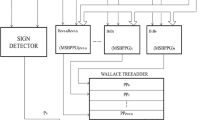Abstract
In this paper we have designed a Split-radix type FFT unit without using multipliers. All the complex multiplications required for this type of FFT are implemented using Distributed Arithmetic (DA) technique. A method is incorporated to overcome the result overflow problem introduced by DA method. Proposed FFT architecture is implemented in 180 nm CMOS technology at a supply voltage of 1.8 V.








Similar content being viewed by others
References
Berkeman, A., Öwall, V., Torkelson, M. (2000). A low logic depth complex multiplier using distributed arithmetic. IEEE Journal of Solid-State Circuits, 35, 656–659.
Perez-Pascual, A., Sanaloni, T., Valls, J. (2002). FPGA-based radix-4 butterflies for HIPERLAN/2. In IEEE international symposium on circuits and systems (pp. 277–280). Scottsdale.
Chang, Y.N., & Parhi, K.K. (2000). High-performance digit-serial complex multiplier. IEEE Transactions on Circuits and Systems, 47, 570–572.
Chen, T., Sunanda, T.G., Jin, J. (1999). COBRA: a 100-MOPS single-chip programmable and expandable FFT. IEEE Transactions Very Large Scale Integrative (VLSI) Systems, 7, 174–182.
Fan, C.-P., Lee, M.-S., Su, G.-A. (2006). A low multiplier and multiplication cost 256-point FFT implementation with simplified radix-16 SDF architecture. In IEEE asia pacific conference on circuits and systems (pp. 1935–1938).
Cooley, J., & Tukey, J. (1965). An algorithm for the machine calculation of complex fourier series. Mathematical Comparative, 19, 297–301.
Duhamel, P., & Hollmann, H. (1985). Implementation of split-radix FFT algorithms for complex, real and real-symmetric data. IEEE International Conference on Acoustics, Speech and Signal Processing, 10, 784–787.
Duhamel, P., & Hollmann, H. (1984). Split radix FFT algorithm. Electronics Letters, 20, 14–16.
Good, I. (1958). The interaction algorithm and practical fourier analysis. Journal of the Royal Statistical Society, B-20, 361–372.
Xiao, H., Pan, A., Chen, Y., Zeng, X. (2008). Low-cost reconfigurable VLSI architecture for fast fourier transform. IEEE Transactions on Consumer Electronics, 54, 1617–1622.
He, S., & Torkelson, T. (1995). A pipelined bit-serial complex multiplier using distributed arithmetic. International Symposium on Circuits and Systems, 3, 2313–2316.
Jiang, R.M. (2007). An area-efficient FFT architecture for OFDM digital video broadcasting. IEEE Transactions on Consumer Electronics, 53, 1322–1326.
Kolba, D., & Parks, T. (1977). A prime factor algorithm using high-speed convolution. IEEE Transaction Acoustics Speech Signal Process, ASSP-25, 281–294.
Maharatna, G., & Jagdhold, U. (2004). A 64-point fourier transform chip for high-speed wireless LAN application using OFDM. IEEE Journal Solid-State Circuits, 39, 484–493.
Morris, L. (1978). A comparative study of time efficient FFT and WFTA programs for general purpose computers. IEEE Transaction Acoustics Speech Signal Process, ASSP-26, 141–150.
Engels, M., Eberle, W., Gyselinckx, B. (1998). Design of a 100 Mbps wireless local area network. In Proceedings IEEE URSI international symposium signals and systems (pp. 253–256).
Jiang, M., Yang, B., Huang, R., Zhang, T.Y., Wang, Y.Y. (2007). Multiplierless fast fourier transform architecture. Electronics Letters, 43, 191-192.
Karlsson, M., Vesterbacka, M., Wanhammar, L. (1997). Design and implementation of a complex multiplier using distributed arithmetic (pp. 222–231).
Nawab, H., & McClellan, J. (1979). Bounds on the minimum number of data transfers in WFTA and FFT programs. IEEE Transaction Acoustics Speech Signal Process, ASSP-27, 394–398.
van Nee, R., & Prasad, R. (2000). OFDM for wireless multimedia communications. Norwell: Archtech House.
Peled, A., & Liu, B. (1973). A new approach to the realization of nonrecursive digital filters. IEEE Transaction Audio and Electroacoustics, 21, 477–485.
Chow, P., Vranesic, Z., Yen, J.L. (1983). A pipelined distributed srithmetic PFFT processor. IEEE Transactions on Computers, 32, 198–206.
Shaditalab, M., Bois, G., Sawan, M. (1998). Self-sorting radix-2 FFT on FPGAs using parallel pipelined distributed arithmetic blocks. In IEEE symposium on FPGAs for custom computing machines (pp. 137–138).
Siu, W., & Chen, C. (1983). New realization technique of high-speed discrete fourier transform described by distributed arithmetic. IEE Proceedings, 130, 177–181.
Weste, N., & Skellern, D.J. (1998). VLSI for OFDM. IEEE Communication Magazine, 36, 127–131.
White, S.A. (1989). Applications of distributed arithmetic to digital signal processing: a tutorial review. IEEE ASSP Magazine, 6, 4–19.
Winograd, S. (1976). On computing the discrete fourier transform. Proceedings of the National Academy of Sciences of the United States of America, 73, 1005–1006.
Hui, W., Ding, T., McCanny, V. (1996). A 64-point fourier transform chip for video motion compensation using phase correlation. IEEE Journal of Solid-State Circuits, 31, 1751–1761.
Li, X., Lai, Z., Cui, J. (2007). A low power and small area FFT processor for OFDM demodulator. IEEE Transactions on Consumer Electronics, 53, 274–277.
Yeh, W.C., & Jen, C.W. (2003). High-speed and low-power split-radix FFT. IEEE Transactions on Signal Processing, 51, 864–874.
Lin, Y.T., Tsai, P.Y., Chiueh, T.D. (2005). Low-power variable-length fast fourier transform processor. IEEE Proceedings Computers and Digital Techniques, 152, 499–506.
Zohar, S. (1973). The counting recursive digital filter. IEEE Transaction on Computers, C-22, 338–347.
Zohar, S. (1973). New hardware realization of nonrecursive digital filters. IEEE Transaction on Computers, C-22, 328–338.
Acknowledgments
This work is carried out using the Synopsys and the Cadence tools provided by the SMDP II project at IIT Guwahati.
Author information
Authors and Affiliations
Corresponding author
Rights and permissions
About this article
Cite this article
Joshi, S.P., Paily, R. Distributed Arithmetic based Split-Radix FFT. J Sign Process Syst 75, 85–92 (2014). https://doi.org/10.1007/s11265-013-0790-y
Received:
Accepted:
Published:
Issue Date:
DOI: https://doi.org/10.1007/s11265-013-0790-y




